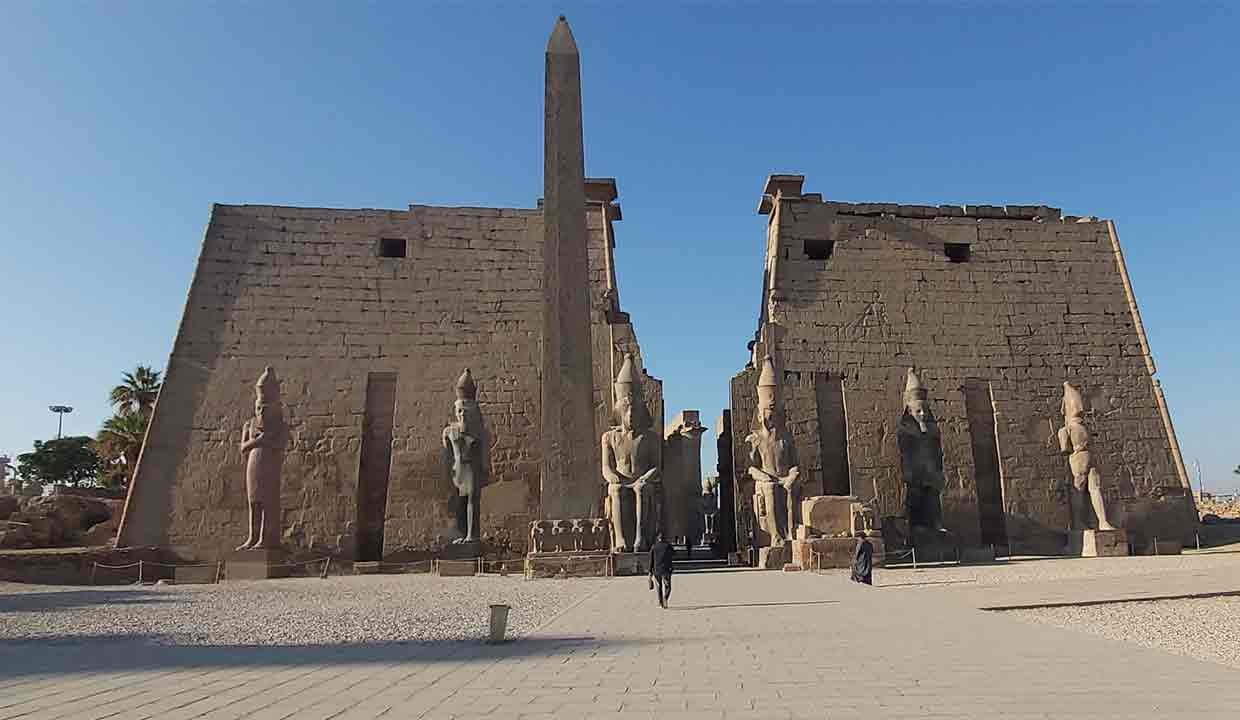Amazing Luxor Temple 5 Facts about Beacon of Kingship.
Explore Luxor Temple: where pharaohs once walked and history blends with timeless spirituality.
In the vast landscape of Egypt’s ancient relics, Luxor Temple stands as a unique testament to the enduring power, religious fervor, and architectural prowess of the pharaohs. It’s not just an archaeological monument, but a window into the amalgamation of religions and eras, spanning thousands of years.
Luxor Temple is a sign of ancient Egyptian civilization, and is a monument of great beauty in the heart of the modern city of Luxor. Although dozens of centuries have passed since its construction, it remains a witness to the greatness of a civilization that did not disappear, and today it is classified as one of the best preserved Egyptian temples and the most beautiful building, and in it the Egyptian temple plan is evident and clearer. One of the inner chambers contains a group of scenes known as Divine Birth Scenes, as it tells the story of King Amenhotep III’s lineage with the idol Amun-Ra himself.
Ramesses II (c.1279-1213 BC) made numerous additions to Luxor temple. In front of the Great Colonnade, he built a peristyle courtyard and a massive pylon, a gate with two towers that served as the entrance to temples. In addition to many colossal statues, the pylon was fronted by a pair of 25-meter-high obelisks built by this great king, of which only one remains; the other has been at the Place de la Concorde in Paris since 1836.
The Romans fortified the temple in the late third century AD, and the first room beyond Amenhotep III’s hypostyle hall served as its sanctuary. The original wall reliefs were covered in plaster and painted in the Graeco-Roman artistic style, depicting Emperor Diocletian (284–305),and his three coregents. Although these had largely disappeared, efforts are under way to restore these reliefs to their former glory.
A Primeval Setting
The ancient Egyptians referred to Luxor Temple as Ipet-resyt “Southern Sanctuary” due to its location within ancient Thebes (modern Luxor). It is located about three kilometers south of Karnak Temple, which was once connected by a procession route flanked by sphinxes. The earliest evidence for this temple dates from the Eighteenth Dynasty (c.1550-1295 BC).
Unlike most other ancient Egyptian temples, Ipet-resyt is oriented towards Karnak rather than east to west. This is because Luxor Temple was the main venue for one of the most important of ancient Egyptian religious celebrations, when the cult images of Amun, his wife Mut, and their son, the lunar god Khonsu, were removed from their temples in Karnak and transported in a grand procession to Luxor Temple so they could visit the god that resides there, Amenemopet. This was the Opet Festival.
Located in today’s modern city of Luxor, which was once the ancient city of Thebes, Luxor Temple lies close to the Nile’s east bank. Unlike many temples which were dedicated to a deity, Luxor Temple was dedicated to the rejuvenation of kingship. It is believed that the temple was where many of the kings of Egypt were crowned.
Architectural Brilliance
The temple complex was largely initiated by Pharaoh Amenhotep III in the 14th century BCE and was later expanded by Ramses II, who added the entrance pylon, statues, and obelisks. One of the original pair of obelisks still stands; its twin now adorns the Place de la Concorde in Paris.
Upon entering, visitors are greeted by the colossal Ramesses II statues and a pathway lined with sphinxes, which originally connected Luxor Temple with the Temple of Karnak 3 km to the north.
Inside, the temple reveals a series of courtyards, chambers, and colonnades adorned with detailed carvings that vividly illustrate various rituals, battles, and stories, including the Opet Festival—a key event linking the two temples.
A Confluence of Cultures
Luxor Temple’s history doesn’t stop with the ancient Egyptians. The site bears the marks of various cultures and religions. There’s the Roman camp, indicating the presence of the Roman Empire, and the Abu Haggag Mosque, built in the 13th century, which is still in use today and stands as a testament to the Islamic era.
This layering of religious and cultural practices demonstrates the temple’s continuing significance across eras, with each civilization respecting the sanctity of the site even as they added their own touch.
Nighttime Magic
One of the unique experiences of Luxor Temple is visiting it after sunset. The temple is beautifully illuminated, casting dramatic shadows and highlighting the detailed hieroglyphics and statues, offering a surreal, timeless atmosphere that transports visitors back to ancient times.

Conservation and Tourism
Luxor Temple, a UNESCO World Heritage site, faces the modern challenges of conservation. While the dry climate of Egypt has done wonders for the preservation of many ancient sites, pollution, groundwater, and the sheer volume of visitors each year can take a toll. Efforts are ongoing to ensure that this gem remains for future generations to experience.
Conclusion
The Luxor Temple is more than just an ancient relic; it’s a living testament to the continuity of human civilization and spirituality, drawing together strands from different epochs into a single, unified tapestry of architectural and cultural splendor. For anyone visiting Egypt, spending a quiet moment amidst its columns and chambers is not just a tour but a communion with the past.


Comment (0)